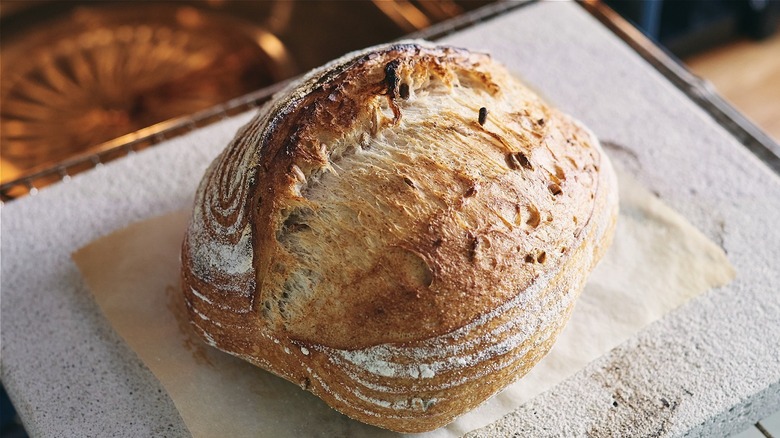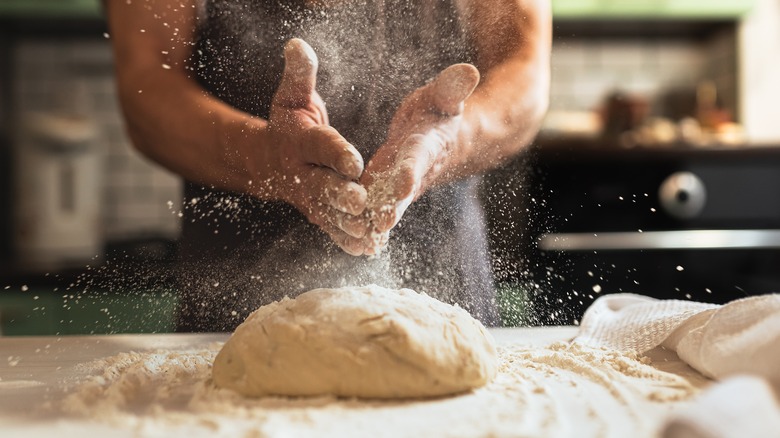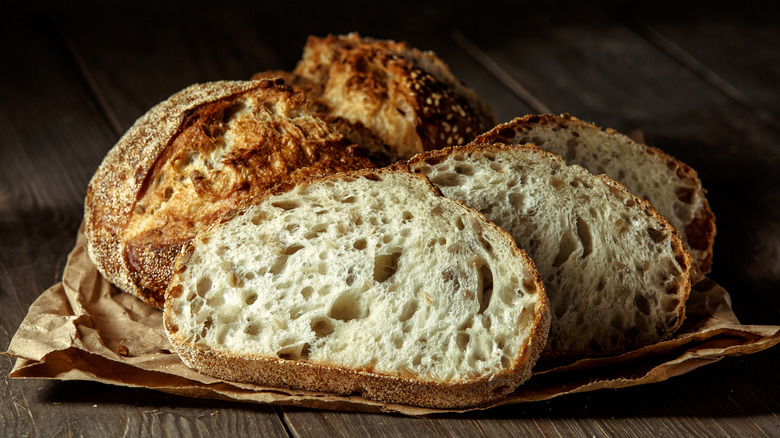Why You Should Open The Oven Door When Baking Sourdough Bread
If you weren't making sourdough bread at the beginning of the pandemic, then what were you doing? When several factors converged in 2020 — additional time spent at home, the need for comfort food, and a shortage of ingredients at the supermarket — home cooks went back to basics, baking to satisfy those needs. Influenced by social media trends and a need to connect with people, we created life.
Worldwide, people began scratch cooking and nursed jars of sourdough starter, feeding the live yeast each day and sharing its discard with friends to connect and offer comfort during difficult times. Along with "The Tiger King" and "How to style curtain bangs," sourdough was the most searched recipe on Google in 2020, peaking in April.
Michel Suas, the co-founder of the San Francisco Baking Institute, wasn't surprised by the popularity of sourdough bread baking. According to Bake Magazine, the institute has seen an increase in home cooks in its classes, making up 40% of the attendees. Along with bakers from across the world, home bakers were spending their vacations in weeklong workshops to better understand the art and science of bread making.
Simple lifestyle YouTube channels like Joshua Weissman and Farmhouse on Boone saw a 4,600% increase in Google searches, with Joshua Weissman's "The Ultimate Sourdough Starter Guide" amassing 6.5 million views and over seven thousand comments.
Whether your sourdough starter celebrated its second birthday earlier this year, or you're late to the bread-baking party, we've got some tips to help bake crusty boules.
Developing a robust sourdough
USA Today and other newspapers reported a shortage of yeast in April 2020, so it makes sense that people turned to baking sourdough since it uses a starter, not commercial yeast, to leaven the bread. The fermented combination of the flour and water starter is what gives sourdough bread its characteristically tangy flavor and chewy consistency. If you've baked bread more than once, you quickly realize the recipe is never the same each time. Factors like moisture in the air, room temperature, and elevation can affect how much flour is added to the sourdough bread dough or how long it takes to rise and do its magic.
According to BBC Good Food, sourdough bread baking is a slow process, requiring hours to days to develop the layers of flavor. Patience is needed as you wake up the starter, bring it to room temperature, and feed it with white flour or a combination of flour (whole wheat, spelt, rye) and water. It's during the autolyze and bulk fermentation stages that the robust flavor of the bread is developed. According to Real Simple, sourdough bread with a high ratio of water to flour or hydration creates the best results, with 70% hydration optimal.
Using steam for a crackly crust
After a series of stretches, rests, and a slash or two, the sourdough is finally ready for the oven. Ensure the baking surface is nonstick by dusting flour or cornmeal or use parchment paper as insurance. Whether you've shaped the dough into a boule (round) or bâtard (long), good bread has a beautiful gold-brown crust. Real Simple suggests covering your bread for the first one-third of the bread-baking process to create that crust, trapping in the steam building as the water in the dough evaporates. This will help the bread expand and develop the crust's color and texture.
During the final five to 10 minutes of baking, however, we want to remove the steam from the oven to keep the bread's crust crispy and crackly. Slightly crack open the oven door during that final stage of baking the bread to allow the steam to escape from the bread's surface and for the oven's environment to become dry to develop the ideal texture on the bread's exterior. According to King Arthur Baking, too much moisture left in the oven once the yeast has died and the bread has stopped expanding will create a "thick, rubbery crust."
The expert bakers at King Arthur Baking suggest waiting another 15 minutes before cutting into the sourdough bread to allow the bread to cool, but that seems cruel after waiting hours or days, so we won't tell anyone.


